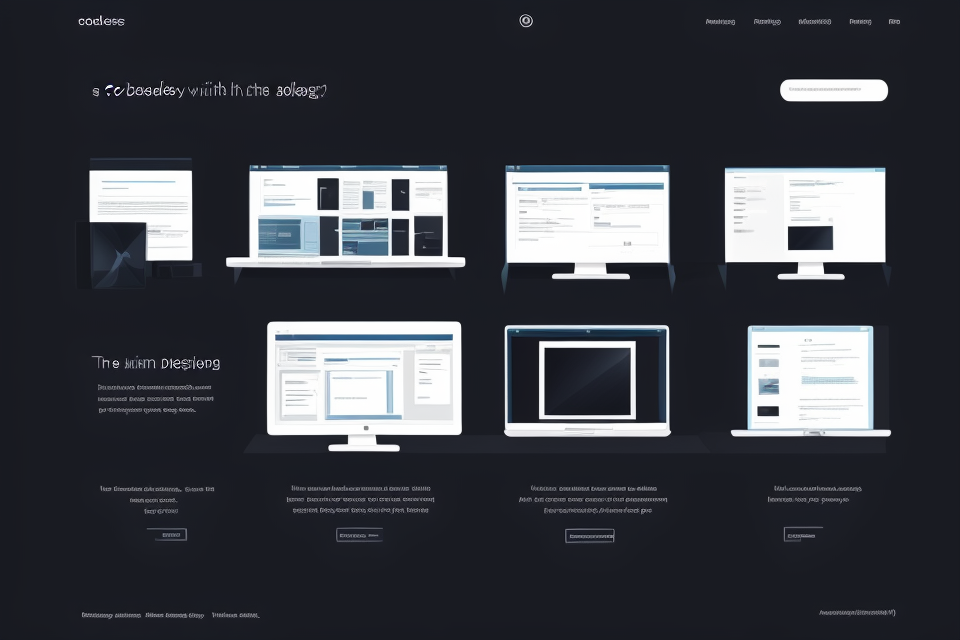The world of web development is constantly evolving, and with it, the debate between Python and Java as the preferred programming languages. Both languages have their unique advantages and disadvantages, and choosing the right one for your project can be a daunting task. In this article, we will explore the pros and cons of Python and Java for web development, and ultimately determine which language reigns supreme. Whether you’re a seasoned developer or just starting out, this article will provide valuable insights to help you make an informed decision. So, let’s dive in and find out which language is best suited for your web development needs.
The Basics: Understanding Python and Java
Python: The High-Level Language
Python, a high-level programming language, was first released in 1991 by its creator Guido van Rossum. Since then, it has become one of the most popular programming languages, widely used in various domains such as web development, data science, artificial intelligence, and more. Python’s simplicity, readability, and ease of use make it an ideal choice for beginners and experienced programmers alike.
Some of the key features of Python that make it a popular choice for web development are:
- Syntax: Python’s syntax is designed to be easy to read and understand, making it simpler for developers to write and maintain code. This simplicity allows for faster development and reduces the chances of errors.
- Libraries: Python has a vast collection of libraries, including popular web development libraries such as Django and Flask. These libraries provide pre-built functionality and reduce the amount of code needed for web development.
- Dynamic typing: Python is a dynamically typed language, which means that variable types are determined at runtime rather than being explicitly declared. This allows for more flexibility in code and reduces the amount of boilerplate code needed.
- Object-oriented programming: Python supports object-oriented programming, which allows developers to create reusable code and modularize their applications. This makes it easier to maintain and update code over time.
- Large community: Python has a large and active community of developers who contribute to its development and share their knowledge through forums, blogs, and other resources. This makes it easier for developers to find help and support when needed.
Overall, Python’s high-level features and vast collection of libraries make it a popular choice for web development. Its simplicity, flexibility, and large community make it an ideal language for building robust and scalable web applications.
Java: The Object-Oriented Language
Brief history of Java
Java was first introduced in 1995 by James Gosling and his team at Sun Microsystems. It was designed to be a portable, object-oriented programming language that could run on any platform with a Java Virtual Machine (JVM) installed. The language was initially called Oak, but it was later renamed to Java due to the company’s involvement with coffee.
Features of Java
Java is an object-oriented language that is known for its platform independence, which means that Java applications can run on any operating system without modification. This is made possible by the JVM, which translates Java bytecode into native machine code at runtime. Other features of Java include:
- Automatic memory management: Java uses a garbage collector to automatically manage memory, which helps to prevent memory leaks and reduces the likelihood of programming errors.
- Exception handling: Java provides a robust exception handling mechanism that allows developers to write more robust and fault-tolerant code.
- Multi-threading: Java supports multi-threading, which allows developers to write highly concurrent and responsive applications.
- Rich libraries: Java has a large standard library that provides a wide range of functionality, including file I/O, networking, and data processing.
Why Java is popular for web development
Java is a popular choice for web development due to its reliability, scalability, and robustness. Some of the key reasons why Java is used for web development include:
- Enterprise-grade applications: Java is well-suited for building large-scale, enterprise-grade applications that require high performance, scalability, and security.
- Large developer community: Java has a large and active developer community, which means that there are many resources available for learning and troubleshooting.
- Robust frameworks: Java has a number of powerful frameworks, such as Spring and Hibernate, that make it easy to build web applications quickly and efficiently.
- Extensive tooling: Java has a wide range of tools available for development, testing, and deployment, including integrated development environments (IDEs), testing frameworks, and deployment tools.
Ease of Use and Learning Curve
Python
Python’s simple syntax
Python is known for its simple and easy-to-learn syntax, which makes it an excellent choice for beginners. The language uses indentation to define code blocks, eliminating the need for curly braces or other special characters commonly found in other programming languages. Additionally, Python’s use of English keywords and minimalistic syntax further simplifies the coding process, enabling developers to focus on the logic of their applications rather than getting bogged down in syntax details.
Wide range of libraries and frameworks
Python’s extensive ecosystem of libraries and frameworks is another factor that contributes to its ease of use. For web development, Python offers popular frameworks such as Django and Flask, which provide developers with a wealth of tools and resources to build robust and scalable web applications. These frameworks often include features such as database integration, authentication, and routing, streamlining the development process and reducing the amount of code required. Additionally, Python’s extensive third-party library support, including libraries for data manipulation, machine learning, and visualization, makes it an ideal choice for a wide range of web development projects.
Python’s community support
Python’s vibrant and supportive community is another factor that makes it an attractive choice for web development. With numerous online resources, forums, and tutorials available, developers can easily find answers to their questions and access a wealth of knowledge and expertise. Additionally, Python’s large and active community of contributors means that many libraries and frameworks are regularly updated and improved, ensuring that developers have access to the latest tools and technologies. This level of support and collaboration can be especially valuable for developers who are new to web development or looking to expand their skillset.
Java
Java’s Strong Type System
One of the primary advantages of Java is its strong type system. This means that variables must be declared with a specific data type, and the compiler will not allow the use of uninitialized variables. This helps prevent common programming errors, such as null pointer exceptions, and ensures that the code is more robust and easier to maintain.
Java’s Extensive Documentation
Java has an extensive and well-organized documentation system that is widely available online. This makes it easier for developers to find answers to their questions and troubleshoot problems quickly. Additionally, Java’s official website provides a wealth of resources, including tutorials, guides, and API documentation, that can help new developers get up to speed quickly.
Java’s Popularity in the Enterprise World
Java is widely used in the enterprise world, with many large companies relying on it for their mission-critical applications. This means that there is a large pool of experienced developers who are familiar with the language and can provide support and guidance to new developers. Additionally, Java’s popularity has led to the development of a large and active community, which can provide valuable resources and support for developers working with the language.
Performance and Speed
Dynamic Nature and Interpreted Code
Python is an interpreted language, meaning that it is not compiled like Java, but rather executed line by line by an interpreter. This dynamic nature allows for more flexibility and ease of use, but it can also lead to slower performance in certain situations.
Can Python be Fast Enough for Web Development?
Despite its dynamic nature, Python can be fast enough for web development, especially when it comes to smaller projects or those that do not require intensive computation. In fact, many popular web frameworks such as Django and Flask are built on Python and are known for their speed and efficiency.
Profiling and Optimizing Python Code
When it comes to performance, profiling and optimizing Python code is crucial. This involves analyzing the code to identify bottlenecks and then implementing techniques such as memoization, caching, and vectorization to improve performance. Additionally, using third-party libraries and packages can also help improve the speed of Python code.
In summary, while Python’s dynamic nature may lead to slower performance in some situations, it is still possible to achieve fast performance in web development with Python through profiling and optimization.
Java’s compiled code and Just-In-Time (JIT) compilation:
Java is a compiled language, which means that the source code is converted into bytecode that can be run on any platform. This allows for cross-platform compatibility, as the same bytecode can run on Windows, Mac, and Linux. However, this also means that the initial compilation process can be slower than interpreted languages like Python.
To improve performance, Java uses Just-In-Time (JIT) compilation. JIT compilation converts the bytecode into native machine code at runtime, which can then be executed more quickly. This can help to speed up the execution of Java programs, but it also requires more memory and processing power than interpreted languages.
Java’s ability to run on any platform:
One of the main advantages of Java is its ability to run on any platform. This is due to the fact that Java programs are compiled into bytecode, which is platform-independent. This means that the same bytecode can run on any operating system, as long as the Java Virtual Machine (JVM) is installed. This can be a significant advantage for web developers, as it allows them to write code that can be run on any server, without the need to worry about platform-specific issues.
Optimizing Java code for better performance:
To improve performance, Java provides a number of tools and techniques for optimizing code. For example, the Java HotSpot VM includes a Just-In-Time (JIT) compiler that can optimize code at runtime. This can help to improve the performance of Java programs, especially for CPU-intensive tasks. Additionally, Java provides a number of tools for profiling and analyzing code, which can help developers to identify and fix performance bottlenecks.
Overall, Java’s ability to run on any platform and its support for optimization make it a good choice for web development, especially for large-scale, enterprise-level applications. However, its compiled code and JIT compilation can make it slower to start up and less efficient than interpreted languages like Python, especially for smaller projects.
Scalability and Maintenance
Python’s Lightweight Code and Ease of Scalability
One of the key advantages of using Python for web development is its lightweight code and ease of scalability. Python’s syntax is designed to be simple and easy to read, which makes it easy to write code that is both efficient and scalable. Additionally, Python’s ability to integrate with other languages and libraries allows for a more modular and scalable codebase.
Python’s Readability and Simplicity
Python’s readability and simplicity are also important factors when it comes to scalability and maintenance. Because Python’s syntax is designed to be easy to read and understand, it’s easier for developers to quickly identify and fix bugs or make changes to the codebase. This makes it easier to maintain and scale the codebase over time, as well as to train new developers on the codebase.
Handling Large-Scale Projects with Python
Finally, Python’s ability to handle large-scale projects is another important factor when it comes to scalability and maintenance. Python’s performance is generally faster than other languages, which makes it well-suited for handling large amounts of data and traffic. Additionally, Python’s extensive library support and ability to integrate with other languages and tools make it easy to build and maintain complex, scalable web applications.
Java’s strong type system and exception handling:
- Java’s type system ensures that variables are explicitly declared with a specific data type, preventing potential errors and increasing code stability.
- Exception handling is built into the language, allowing developers to handle errors gracefully and maintain the program’s stability.
Modular code structure for easier maintenance:
- Java’s modular code structure enables developers to create reusable code components, reducing redundancy and making maintenance more manageable.
- This approach helps in isolating bugs and making changes, leading to more efficient development and maintenance processes.
Java’s large community and vast resources:
- The Java community is extensive, with numerous resources, forums, and documentation available for developers.
- This support system helps developers stay up-to-date with the latest trends, tools, and best practices, enabling them to work more effectively and maintain their projects efficiently.
By focusing on scalability and maintenance, Java demonstrates its strengths as a web development language. Its strong type system, exception handling, modular code structure, and vast community resources contribute to the overall stability and manageability of web applications built with Java.
Web Development Frameworks
Python is a popular language for web development, with a range of frameworks available to choose from. Some of the most commonly used frameworks for Python web development include Flask, Django, and Pyramid.
Flask
Flask is a lightweight web framework that is easy to use and learn. It is ideal for small to medium-sized projects, and its simple and modular design makes it easy to add functionality as needed. Flask is also highly customizable, which makes it a popular choice for developers who want to build custom solutions.
Django
Django is a more robust framework than Flask, and it is well-suited for larger projects. It is known for its batteries-included approach, which means that it comes with a range of built-in features and tools that make it easy to build complex web applications. Django’s admin interface is also highly customizable, which makes it easy to manage data and content in a web application.
Pyramid
Pyramid is a more flexible framework than Django or Flask, and it is designed to be highly adaptable to different project requirements. It is also highly extensible, which means that it can be easily customized to meet the needs of specific projects. Pyramid is a good choice for developers who want to build highly customized web applications.
Overall, Python offers a range of web development frameworks that are well-suited to different project requirements. Whether you are building a small project or a large-scale web application, there is a Python framework that can help you achieve your goals.
Spring
Spring is a powerful and popular framework for Java web development. It provides a comprehensive set of tools and libraries for building enterprise-level web applications. Some of the key features of Spring include:
- Inversion of Control (IoC) container: This allows for more modular and flexible code, making it easier to manage dependencies and improve maintainability.
- Aspect-Oriented Programming (AOP) support: This allows for better separation of concerns and modularization of code.
- Data access and integration: Spring provides a wide range of tools for data access and integration, including JDBC, Hibernate, and JPA.
- Security: Spring provides a robust security framework that can be used to secure web applications and handle authentication and authorization.
Play Framework
Play Framework is a high-level web framework for Java that is designed to make web development faster and more fun. It is built on top of the Java Servlet API and provides a set of high-level abstractions for building web applications. Some of the key features of Play Framework include:
- Convention over configuration: Play follows a convention-over-configuration approach, which means that developers can focus on writing code and not worry about configuring the framework.
- Real-time updates: Play supports real-time updates, which makes it easy to build applications that require real-time updates, such as chat applications.
- Built-in security: Play provides a built-in security framework that can be used to secure web applications and handle authentication and authorization.
- High-performance: Play is designed to be fast and scalable, making it a good choice for building high-traffic web applications.
Struts
Struts is a popular framework for building web applications in Java. It provides a set of tools and libraries for building web applications, including support for MVC (Model-View-Controller) architecture. Some of the key features of Struts include:
- Taglib: Struts provides a set of tags that can be used to easily generate HTML and other markup languages.
- MVC support: Struts provides a set of tools for implementing the MVC architecture, which makes it easier to build web applications with a clear separation of concerns.
- Validation: Struts provides a set of tools for validating user input, which helps to ensure that web applications are secure and reliable.
- Internationalization: Struts provides support for internationalization, which makes it easy to build web applications that can be used by users in different countries and regions.
Comparing Python and Java Frameworks
When it comes to web development, both Python and Java offer robust frameworks that provide developers with a variety of tools and resources to build dynamic and scalable web applications. However, there are key differences between the two that make them more or less suitable for different projects.
Pros and Cons of Each Framework
Python Frameworks
Python has become increasingly popular in recent years due to its simplicity and ease of use. It offers a variety of web development frameworks, including Django and Flask, which provide developers with powerful tools to build web applications quickly and efficiently.
Some of the advantages of using Python for web development include:
- Python’s dynamic typing and automatic memory management make it easy to write and maintain code.
- Python has a vast library of third-party packages and modules that can be easily integrated into web applications.
- Python’s simple syntax and readability make it easier for developers to write and understand code.
However, there are also some drawbacks to using Python for web development, including:
- Python’s dynamic typing can lead to errors and bugs in code if not properly managed.
- Python’s lack of a standard way to handle concurrency and parallelism can make it challenging to build high-performance web applications.
- Python’s syntax can be less concise and expressive than other languages, which can make it harder to write and maintain large-scale applications.
Java Frameworks
Java, on the other hand, has been a popular choice for web development for many years due to its scalability, performance, and robust security features. Java offers a variety of web development frameworks, including Spring and Struts, which provide developers with a range of tools and resources to build dynamic and scalable web applications.
Some of the advantages of using Java for web development include:
- Java’s strong typing and object-oriented programming (OOP) features make it easier to catch errors and bugs in code.
- Java’s built-in support for multithreading and concurrency makes it easier to build high-performance web applications.
- Java’s vast library of frameworks and tools provides developers with a wealth of resources to build complex web applications.
However, there are also some drawbacks to using Java for web development, including:
- Java’s verbose syntax and complex object-oriented programming (OOP) features can make it harder to write and maintain code.
- Java’s memory management can be complex and difficult to manage, especially for large-scale applications.
- Java’s lack of a standard way to handle concurrency and parallelism can make it challenging to build high-performance web applications.
Popularity and Use Cases for Each Framework
In terms of popularity, both Python and Java have a large and dedicated community of developers who use their respective frameworks for a variety of web development projects.
Python is particularly popular among startups and small businesses due to its simplicity and ease of use. It is also a popular choice for data-driven web applications, such as e-commerce sites and content management systems.
Java, on the other hand, is particularly popular among large enterprises and government organizations due to its scalability, performance, and robust security features. It is also a popular choice for high-performance web applications, such as financial trading platforms and e-health systems.
Choosing the Right Framework for Your Project
When it comes to choosing the right framework for your web development project, there are several factors to consider, including the size and complexity of the project, the available resources and tools, and the skill level of the development team.
If you are working on a small project with a tight deadline, Python’s simplicity and ease of use may make it the best choice. However, if you are working on a large-scale project with complex requirements, Java’s scalability and performance may be more suitable.
Ultimately, the choice between Python and Java will depend on the specific needs and goals of your project. Both languages offer powerful frameworks and tools that can help you build dynamic and scalable web applications, but
FAQs
1. What is web development?
Web development is the process of creating and maintaining websites. It involves designing the layout, writing the content, and adding functionality to make the website interactive and engaging for users. Web development can be done using various programming languages, frameworks, and tools.
2. What is Python?
Python is a high-level, interpreted programming language that is easy to learn and use. It is widely used in web development due to its simplicity, readability, and flexibility. Python has a vast ecosystem of libraries and frameworks, such as Django and Flask, that make it easy to build web applications quickly.
3. What is Java?
Java is a popular object-oriented programming language that is known for its robustness, scalability, and security. It is used in a wide range of applications, including web development. Java has a strong ecosystem of frameworks, such as Spring and Struts, that make it easy to build complex web applications.
4. What are the pros and cons of Python for web development?
Python has several advantages for web development, including its simplicity, readability, and flexibility. It also has a vast ecosystem of libraries and frameworks, such as Django and Flask, that make it easy to build web applications quickly. However, Python may not be as fast as other languages, and its memory management can be a challenge.
5. What are the pros and cons of Java for web development?
Java has several advantages for web development, including its robustness, scalability, and security. It also has a strong ecosystem of frameworks, such as Spring and Struts, that make it easy to build complex web applications. However, Java may have a steeper learning curve than Python, and its syntax can be verbose.
6. Which language is better for web development, Python or Java?
The choice between Python and Java for web development depends on your specific needs and preferences. Both languages have their own strengths and weaknesses, and the best language for you will depend on factors such as your experience level, the complexity of your project, and your preferred development style. Ultimately, the most important thing is to choose a language that you are comfortable with and that will allow you to build high-quality web applications.



